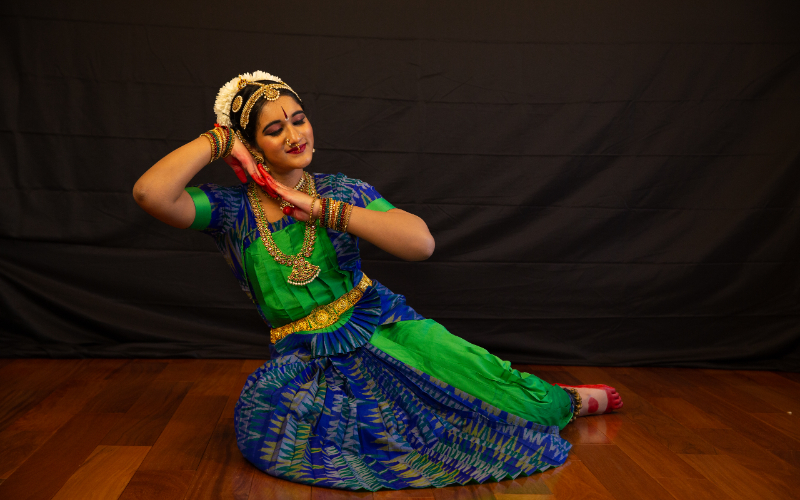Class Curriculum

MYTHILI DANCE ACADEMY
Class Curriculum
Students as young as kindergarten to older students from ages five and up, are introduced to the joys of movement, music and imagination as they learn the fundamentals of Bharatanatyam.
MDA's integrated curriculum for Bharatanatyam begins with adavus or basic foundational steps starting with Tatta Adavus, Natta Adavus, and Pukka Adavus etc which are the basic steps of Bharatanatyam; followed by Hasta Mudras, the hand gestures; and eventually the Abhinaya or Bhavam, the facial expressions.
Rhythmic patterns and storytelling movements are gradually introduced to the dancers as they master the dance steps and theatrical expressions associated with this art form. Once the students have learned the fundamentals of the Bharatanatyam techniques, dances from the repertoire are introduced to them in preparation for their Arangetram, or solo dance debut if they so desire. Regardless of whether the students do their arangetram, students will be taught the full margam to pursue advanced level training if they choose to do so. This highly formalized training offers the dancer an opportunity to develop skill, grace, and discipline. Utilizing this foundation, the students will be encouraged to develop their own movement vocabulary based on Bharatanatyam tradition.
Along with the ongoing training in Bharatanatyam, students perform annually at MDA's Student Showcase/Annual Day Event to showcase their skills and gain experience through performances. Students at all levels participate and perform at various prestigious Indian and American mainstream events throughout the year.

The foundation of Bharatanatyam training is developed through learning Adavus, which encompass all of the basic grounding vocabulary. Additionally, MDA focuses on posture and balance to give students a deeper awareness of the body, coordination, motor skills, and comprehension of basic rhythm. Level I culminates with the knowledge of the Hasta Mudras, the Single and Double handed gestures, the Drishti Bheda (eye movements), Shiro Bheda (head movements), and Greva Bheda (neck movements).

Students develop strength and tone as they work towards mastering their Adavus. Skills increase in speed and rhythm through more complicated sequences, and students are introduced to Abhinaya or Bhavam, an expressional dance. They will learn 8 to 10 dances. By the end of Level II, students have begun their journey to understanding the theory of Bharatanatyam and over the next several years they work on developing Angashuddham (clean body lines and movement). In addition to this, students will be imparted a more in-depth knowledge of both practical and theory aspects like Nava Rasa, History of Dance, Nayika Bheda, etc. in accordance with The Natyashastra.

Dancers develop excellence in their movements, technical precision and have the endurance to complete longer, 20-30 minute pieces, advanced dances that engage deeper Abhinaya (expression) and substantial choreography through Varnams, Shiva Tandavams and demanding Thillanas. At this level, dancers have the opportunity to perform outside of the school, at MDA venues and outreach programs. Level III culminates with a full Margam or Bharatanatyam repertoire, which is intended to demonstrate the dancer's advancement in performance, including advancement in discipline, expression and attitude. Advancement to Level 4 requires delivery of strength and accuracy.

Beginning with Level 4, at this advanced level, dancers receive ongoing one on one training with the Guru Rama Suresh to facilitate solo performances, dance company performances, and development as a teacher. This level focuses on working with the Guru and MDA faculty to deepen the development of a dancer’s art. Students also become eligible to perform an Arangetram if they so desire, dependent upon their development in all skill areas. The Arangetram is a culminating solo performance that defines their potential artistic passage to the professional level. Regardless of whether the students do their arangetram or not, students will be taught the full margam to pursue advanced level training if they choose to do so.
